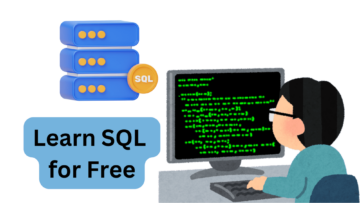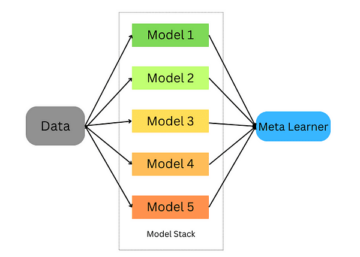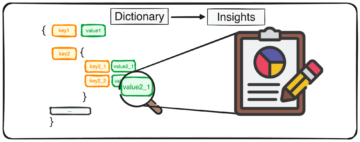Peter Sondergaard once said that information is the oil of the 21st century and analytics is the combustion engine. Nowadays, it is hard to disagree with him.
Like large-capacity tanks to store oils, you need databases to store information. Due to the increasing amount of information, databases have evolved too much since they were first made available.
In this article, we’ll explore databases by looking at the answers to fundamental questions. Then, we’ll discover current popular databases by splitting them into meaningful divisions. Buckle up, and let’s get started!
Let’s start with a general overview of the varied database landscape. In this section, we’ll overview the many databases accessible for different purposes and circumstances in five different categories:
- Lightweight Databases
- Enterprise-Level Relational Databases
- NoSQL Databases
- NewSQL and Distributed Databases
- Specialized and Niche Databases
Let’s start with the lightweight databases.

Image by Author
In this section, we’ll explore lightweight databases, vital elements for applications operating on a lesser scale.
They are known for their efficacy and simplicity. These databases are ideal for undertakings that do not require a heavy, sophisticated database system.
MySQL
MySQL is trendy, especially for websites. It’s fast and has many helpful features. A big community supports it, so much help is available. However, making MySQL handle all that extra work can be challenging when your app gets big. It could be better for complicated data analysis.
SQLite
This simple and small database is excellent for small programs or apps. It’s easy to move around because it’s just a file. But, if many people use the app simultaneously, SQLite might need help keeping up. There are better choices for really big or complex apps.
PostgreSQL
PostgreSQL is free to use and has lots of nice features. It’s great for dealing with complex data and doing tricky things with that data. But, if your app needs to write a lot of data all the time, PostgreSQL might slow down.
MariaDB
MariaDB improves MySQL performance and security. Since MariaDB has characteristics similar to MySQL, you can transition quickly if you know MySQL. However, it’s somewhat less prevalent than MySQL.

Image by Author
Enterprise-level relational databases are suitable for large and complicated applications. They offer enhanced security and extensive data management, which are business needs for enterprises.
Microsoft SQL Server
Microsoft SQL Server is a good choice if you build apps using other Microsoft products, like .NET. It’s known for being remarkably safe and reliable. The downside is that it primarily works with Windows and can be expensive.
Oracle Database
Oracle is known for being very reliable and robust. It’s a top pick for huge companies. It has advanced security and can handle lots of data well. But Oracle is pricey, has a lot of complex rules for using it, and needs to learn.
IBM Db2
IBM DB2 is made for big businesses. It’s great for analyzing data and learning from it. It’s reliable and can handle a lot of work. But it’s tough to manage and usually best for big organizations or unique business needs.
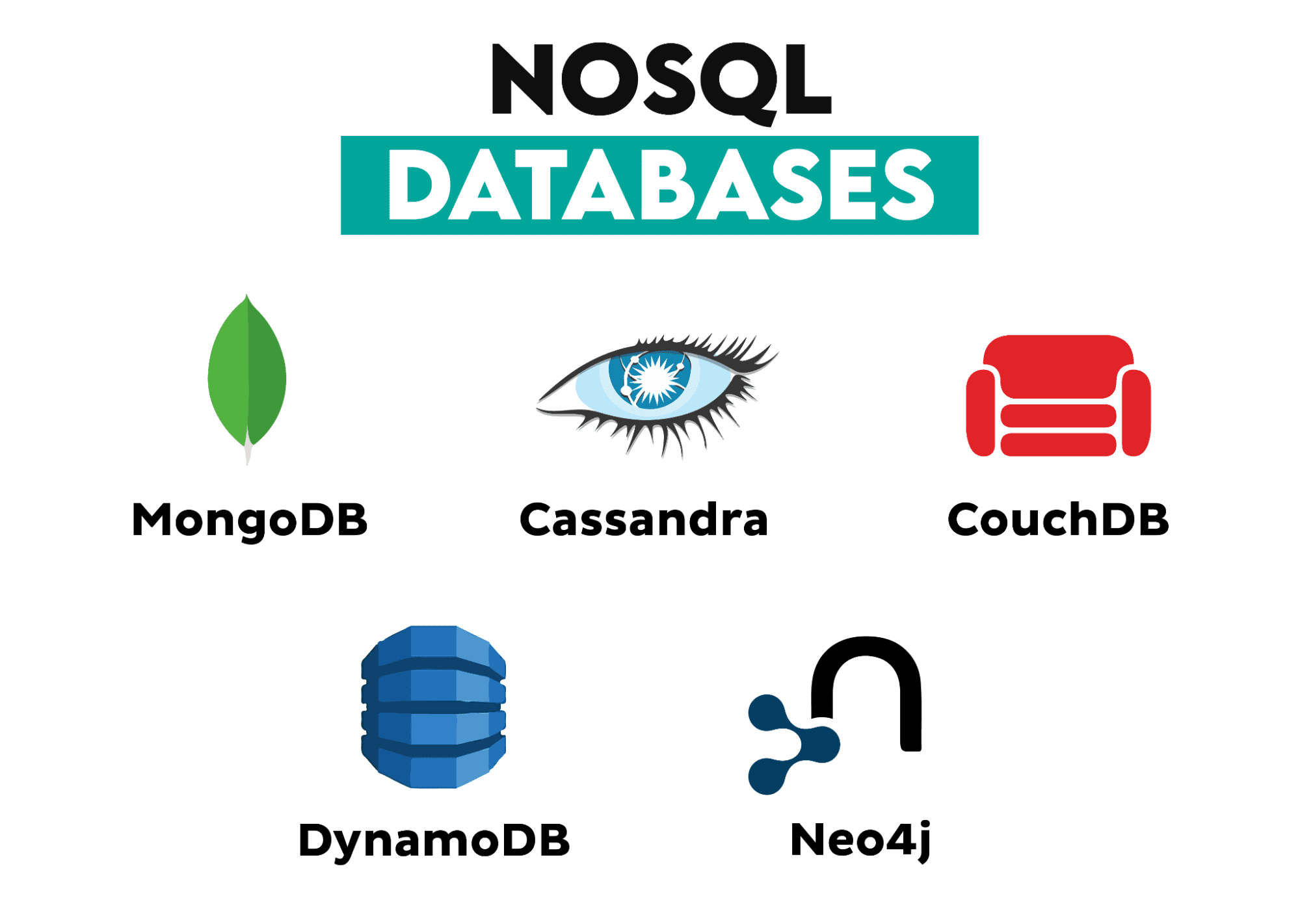
Image by Author
NoSQL databases offer flexibility and scalability. This sector covers databases for unstructured and semi-structured data that meet current, dynamic data needs.
MongoDB
This flexible database doesn’t need a fixed structure, which is excellent for managing many different data types. It can grow to handle more work and has a powerful way to find data.
But, it could be better for tasks that need complex connections between data, as some traditional databases do.
Cassandra
Cassandra has been built to handle vast amounts of data over many computers. It’s very scalable and reliable. But, planning how to store your data in Cassandra can be tricky, and it’s harder to learn if you’re used to traditional databases.
CouchDB
CouchDB is suitable for web apps needing a simple, scalable database that uses JSON, a popular data format. It has an excellent web interface and can copy data well between places. However, it might be better than others for very complex searches or vast amounts of data.??
DynamoDB
DynamoDB is a part of Amazon’s cloud services. It’s good at adjusting to changing workloads and can handle a lot of traffic. But, its options for searching and organizing data are limited. So, it can get expensive.
Neo4j
Neo4j is excellent for connected data, like social networks or recommendation systems. It’s special because it can handle complex relationships between data well. But it’s niche and can be hard to set up.
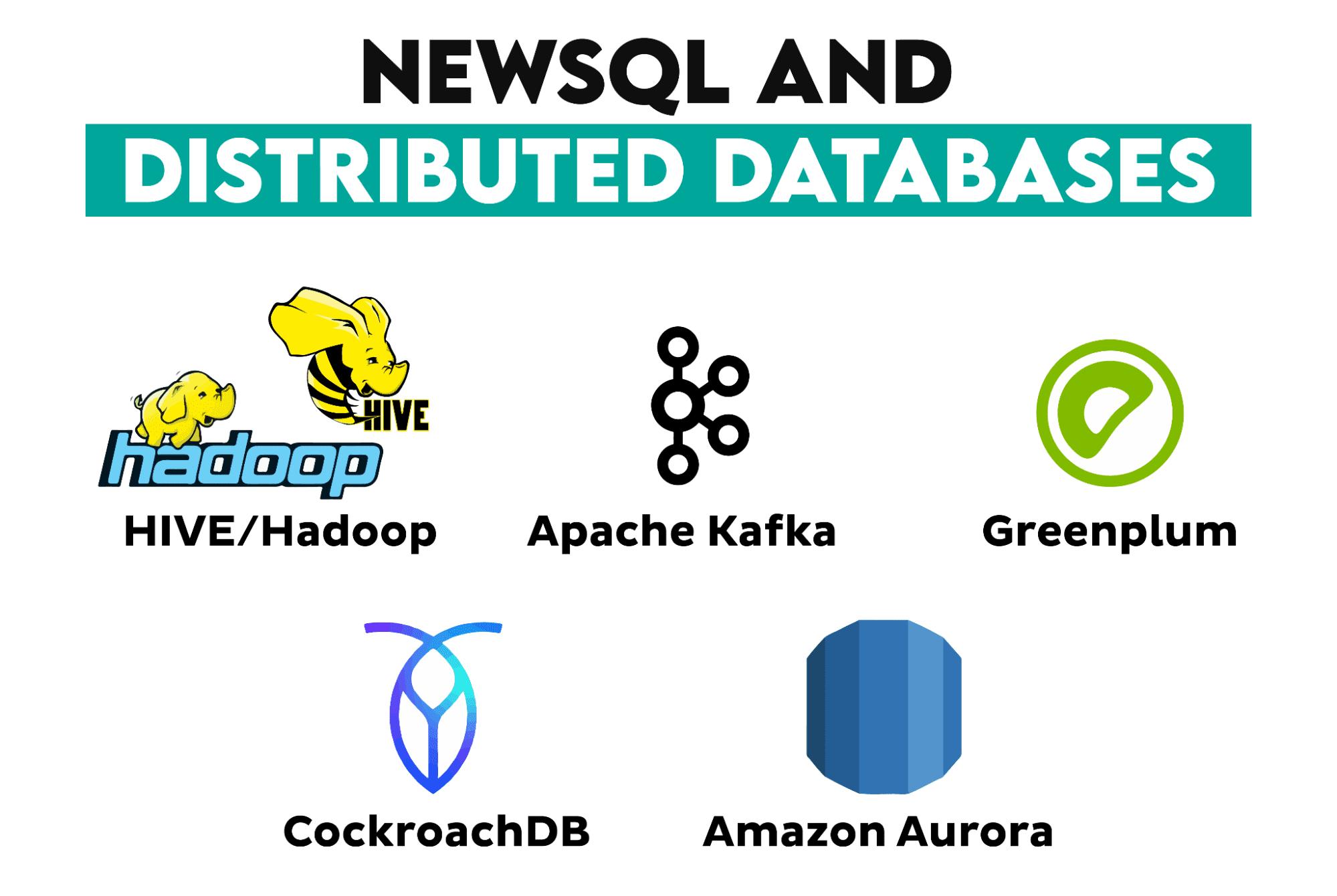
Image by Author
They combine the stability of conventional databases with the scalability of NoSQL systems; let’s start discovering them.
HIVE/Hadoop
Hive, part of the Hadoop ecosystem, is excellent for processing large datasets using simple queries. It’s designed to handle big data and works well with complex data analysis. However, Hive can be slow with real-time questions and may not be the best choice for fast, interactive applications.
Apache Kafka
Apache Kafka is primarily a streaming platform that is excellent for processing and analyzing real-time data streams. It’s highly scalable and reliable for managing large flows of data. However, Kafka is more of a data processing tool than a traditional database, so it’s complex to set up and requires specific expertise to manage effectively.
Greenplum
Greenplum can handle big data analytics very well. It can grow to handle more data and works well with machine learning tools. However, setting it up and managing it can be complex, and it needs a lot of computer resources.
CockroachDB
It’s strong and consistent, even across many computers. It can grow easily and handle transactions like traditional databases. However, its design is complex, and it might be too much for smaller applications.
Amazon Aurora
Amazon Aurora is Part of Amazon’s cloud. It works fast and is compatible with MySQL and PostgreSQL. Designed for the cloud, it’s reliable and can handle much work. However, it can be expensive with more use and is mostly only in Amazon’s cloud.
Amazon Aurora is Part of Amazon’s cloud. It works fast and is compatible with MySQL and PostgreSQL. Designed for the cloud, it’s reliable and can handle much work. However, it can be expensive with more use and is mostly only in Amazon’s cloud.

Image by Author
Finally, we explore specialized and niche databases. These databases are tailored to specific data types and offer features that regular databases may not. From real-time analytics to complicated data modeling, this section covers customized technologies.
Elasticsearch
Elasticsearch is great for searching through text and analytics. It can handle a lot of data and grows well. However, it can be hard to manage in big setups, and it isn’t usually the central database.
RethinkDB
RethinkDB is designed for real-time web apps. It allows flexible data organization and easy updates. However, its development has slowed, so it’s less advanced than others, and support may be limited.
ArangoDB
ArangoDB Supports different types of data, like documents and graphs, and works well for various needs. It performs well, but it could be more well-known, which could mean a harder learning process and less community help.
InfluxDB
InfluxDB is optimized for data that changes over time, like in IoT. It’s great for real-time analysis and monitoring. However, it’s specialized for time-based data, so it’s not ideal for all database needs.
Redis
Redis is super fast because it stores data in memory, which makes it excellent for quick data access and real-time apps. However, the amount of data is limited to memory size, and ensuring data stays safe over time can be tricky.
If you want to discover interview questions about databases, check this one, Database Interview Questions.
We’ve just explored even the deep corners of database worlds by showcasing their strengths and weaknesses and splitting them into categories.
Zig Ziglar once said, “Repetition is the mother of learning.” His words hold for this knowledge as well. So, if you want to solidify your understanding, remember to practice repetition.
Nate Rosidi is a data scientist and in product strategy. He’s also an adjunct professor teaching analytics, and is the founder of StrataScratch, a platform helping data scientists prepare for their interviews with real interview questions from top companies. Nate writes on the latest trends in the career market, gives interview advice, shares data science projects, and covers everything SQL.
- SEO Powered Content & PR Distribution. Get Amplified Today.
- PlatoData.Network Vertical Generative Ai. Empower Yourself. Access Here.
- PlatoAiStream. Web3 Intelligence. Knowledge Amplified. Access Here.
- PlatoESG. Carbon, CleanTech, Energy, Environment, Solar, Waste Management. Access Here.
- PlatoHealth. Biotech and Clinical Trials Intelligence. Access Here.
- Source: https://www.kdnuggets.com/what-is-a-database-everything-you-need-to-know?utm_source=rss&utm_medium=rss&utm_campaign=what-is-a-database-everything-you-need-to-know
- :has
- :is
- :not
- $UP
- 21st
- a
- About
- access
- accessible
- across
- adjunct
- adjusting
- advanced
- advice
- All
- allows
- also
- Amazon
- amount
- amounts
- an
- analysis
- analytics
- analyzing
- and
- answers
- app
- applications
- apps
- ARE
- around
- article
- AS
- At
- Aurora
- available
- BE
- because
- been
- being
- BEST
- Better
- between
- Big
- Big Data
- buckle
- build
- built
- business
- businesses
- but
- by
- CAN
- Can Get
- Career
- categories
- central
- Century
- challenging
- Changes
- changing
- characteristics
- check
- choice
- choices
- circumstances
- Cloud
- cloud services
- combine
- community
- Companies
- compatible
- complex
- complicated
- computer
- computers
- connected
- Connections
- consistent
- conventional
- copy
- corners
- could
- covers
- Current
- customized
- data
- data access
- data analysis
- Data Analytics
- data management
- data processing
- data science
- data scientist
- Database
- databases
- datasets
- dealing
- deep
- Design
- designed
- Development
- different
- discover
- discovering
- distributed
- do
- documents
- doesn
- doing
- down
- downside
- due
- dynamic
- easily
- easy
- ecosystem
- effectively
- efficacy
- elements
- Engine
- enhanced
- ensuring
- enterprises
- especially
- Ether (ETH)
- Even
- everything
- evolved
- excellent
- expensive
- expertise
- explore
- Explored
- extensive
- extra
- FAST
- Features
- File
- Find
- First
- five
- fixed
- Flexibility
- flexible
- Flows
- For
- format
- founder
- Free
- from
- fundamental
- General
- get
- gets
- gives
- good
- graphs
- great
- Grow
- Grows
- Hadoop
- handle
- Hard
- harder
- Have
- he
- heavy
- help
- helpful
- helping
- highly
- him
- his
- Hive
- hold
- How
- How To
- However
- HTTPS
- huge
- ideal
- if
- improves
- in
- increasing
- information
- interactive
- Interface
- Interview
- interview questions
- Interviews
- into
- iot
- isn
- IT
- ITS
- json
- just
- kafka
- KDnuggets
- keeping
- Know
- knowledge
- known
- landscape
- large
- latest
- LEARN
- learning
- less
- lesser
- lightweight
- like
- Limited
- looking
- Lot
- lots
- machine
- machine learning
- made
- MAKES
- Making
- manage
- management
- managing
- many
- many people
- Market
- May..
- mean
- meaningful
- Meet
- Memory
- Microsoft
- might
- modeling
- monitoring
- more
- mostly
- mother
- move
- much
- MySQL
- Need
- needing
- needs
- net
- networks
- nice
- niche
- nowadays
- of
- offer
- Oil
- oils
- on
- once
- ONE
- only
- operating
- optimized
- Options
- or
- oracle
- organization
- organizations
- organizing
- Other
- Others
- over
- overview
- part
- People
- performance
- performs
- pick
- Places
- planning
- platform
- plato
- Plato Data Intelligence
- PlatoData
- Popular
- Postgresql
- powerful
- practice
- Prepare
- prevalent
- primarily
- process
- processing
- Product
- Products
- Professor
- Programs
- projects
- purposes
- queries
- Questions
- Quick
- quickly
- RE
- real
- real-time
- real-time data
- really
- Recommendation
- regular
- Relationships
- reliable
- remember
- require
- requires
- Resources
- robust
- rules
- s
- safe
- Said
- Scalability
- scalable
- Scale
- Science
- Scientist
- scientists
- searches
- searching
- Section
- sector
- security
- server
- Services
- set
- setting
- Shares
- showcasing
- similar
- Simple
- simplicity
- simultaneously
- since
- Size
- slow
- slowed
- small
- smaller
- So
- Social
- social networks
- solidify
- some
- somewhat
- sophisticated
- special
- specialized
- specific
- SQL
- Stability
- start
- stays
- store
- stores
- Strategy
- streaming
- streams
- strengths
- strong
- structure
- suitable
- Super
- Super fast
- support
- Supports
- system
- Systems
- T
- tailored
- Tanks
- tasks
- Teaching
- Technologies
- text
- than
- that
- The
- their
- Them
- then
- There.
- These
- they
- things
- this
- Through
- time
- to
- too
- tool
- tools
- top
- tough
- traditional
- traffic
- Transactions
- transition
- Trends
- tricky
- types
- understanding
- unique
- unstructured
- Updates
- use
- used
- uses
- using
- usually
- varied
- various
- Vast
- Ve
- very
- vital
- want
- Way..
- we
- weaknesses
- web
- websites
- WELL
- well-known
- were
- What
- What is
- when
- which
- windows
- with
- words
- Work
- works
- world’s
- write
- you
- Your
- zephyrnet



